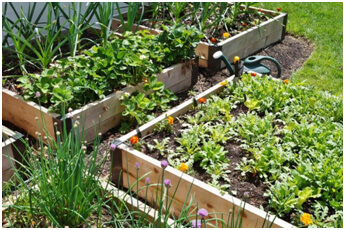Do you know why growing your own garden may hold the secret to your survival? Many households today resort to growing their own gardens and pocket gardens for obvious reasons– sustainability. A rewarding and practical thing to do, growing your own vegetables, herbs, and fruit-bearing plants can truly help augment the health consciousness of each and every member of the family. With talks of natural and manmade disasters always taking centerstage, the need to know more about this sustainable practice has also risen over time. When thinking of growing your own, here’s an excellent survival garden guide to get you started.

Source: intothejungle.org
Planning A Survival Garden
To jumpstart your survival garden, the first decision to make is the location. An excellent place to grow edible plants is right where it can harness the power of the sun at least 3 to 6 hours a day. Plants need sunlight to grow. While some herbs and veggies can be grown indoors, you will need artificial lighting to grow those succulents.
It must also have good access to a water source like a faucet or a deep well. Plants need water to grow. So find an area that also allows you to simply hook on a hose or install sprinklers that will help automate watering of plants or set up an irrigation system in place. Additionally, you will also need good drainage to ensure that excess water won’t seep into your abode (particularly for indoor gardens). It must also be free from silt with large stones as protective barriers. Of course, it must also be accessible from your end to allow easy tending to them. It must also be protected from outside elements like pests and vermin as well as from roving eyes of strangers and thieves.
Survival Garden Layout
Before deciding on a garden layout, it is important to consider the best plants to grow in your particular area. Keep in mind that different plants thrive in different climate zones. Knowing your plant hardiness zone will make you choose the right plants and seeds to grow. Once, you have already identified the plants and seeds you wish to grow, it is now time to make a written chart for their placement.
Perennial vegetables like rhubarb, ginger, garlic, asparagus, horseradish, and artichokes; perennial herbs ike mint, basil, chives, rosemary, thyme, oregano, parsley, and sage; and perennnial berries are often placed together– and as a rule: placed at the back of the garden where there’s less foot traffic and gardening activities. These items are often harvested all throughout the season. Adequate consideration must also be made on “incompatible” plants or plants which require some form of “growth space”. Potatoes and broccoli, for instance, slow down the growth of tomato and squash. Beans prevent onions from sprouting while carrots can prevent dill plants from growing. Peppers, however, love to grow together while lettuce and tomatoes love to grow a foot or two away from others. Vine or crawling edibles also grow best on top of plants that don’t need as much sunshine.
Knowing full well where and what to place in your survival garden will help keep your yield in good condition.
Best Plants To Grow
As mentioned, it is also essential to list down the types of vegetables you wish to grow. From there, you can plan out how to organize your space to ensure growth and protection from elements. Keep in mind that plant choices must be focused on your household’s need. Simply put, choose vegetables, fruits, and herbs that your family members will eat or use for cooking.
Some of the commonly grown plants to aid in a sustainable home are: potatoes, beets, sweet potatoes, beans, eggplants, tomatoes, peanuts, carrots, peas, cabbages, berries, lemon/lime, grain corn, broccoli, squash, onions, bittergourd, malunggay, spinach, and so on. Aside from cooking and eating, choosing plants that help preserve your food pantry also helps.
Survival Seeds
Choosing survival seeds for your garden is a matter of personal preference. Most herbs and crops, by the way, start from seeds then, cultivated in pots or cans or in a patch of land. The great thing about these survival seeds is that they don’t stop delivering yields to satisfy the household’s needs in terms of adding flavor to cooked for as well as in treating health conditions.
Some of the widely cultivated survival seeds are: asparagus, barley, beans, broccoli, carrot, cauliflower, corn, cucumber, eggplant, kale, lettuce, melon,okra, onion, garlic, peanuts, peas, peppers, potatoes, pumpkin, radish, spinach, squash, tomatoes, turnips, wheat, zucchini, cantaloupe, watermelon, clover, and so on. If you plan to raise livestocks, yields from these can also help in feeding them. Here’s Survival Seed Vault Non-GMO Heirloom Seeds to begin with. With 20 easy-to-grow all-growing-zone-friendly seed varieties, you are guaranteed a sustainable survival garden for life.
Without a doubt, growing your own food supply is the wisest thing to do. This survival garden guide aims to give you a bird’s eyeview on what to do when starting out for the first time. By simply following the aforementioned information, you can very well grow and harvest succulent food supply to truly make your home self-sufficient when disaster strikes.








Leave a Reply
You must be logged in to post a comment.